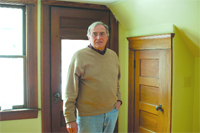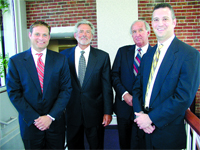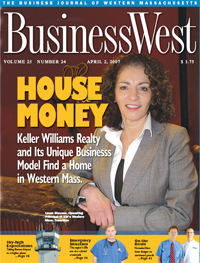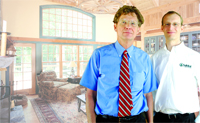When Texas-based Keller Williams Realty launched a franchise in Western Mass., some competitors openly conjectured that the venture wouldn’t last 90 days. Four years later, the KW franchise is moving up in the rankings and is within sight of a very ambitious goal — becoming the number one broker in the area. This explosive growth results from many factors, but especially a unique operating model that places the agents, not the broker, at the center of the home-selling universe.
Laura Stevens says she went, but with the thought that the meeting would be little more than an intelligence-gathering mission on what would inevitably become a new, potentially troublesome competitor.
That’s how she recalls the invite she accepted in March 2003 from officials with Austin, Texas-based Keller Williams Realty to discuss the possibility of a franchise in Western Mass., with her playing a lead role in that venture. Stevens, then an agent with Coldwell Banker, had met representatives of KW, as it’s called, at the annual convention of the National Assoc. of Realtors in New Orleans five months earlier, and told them that when they were ready to make their move into the Greater Springfield market they should give her a call.
They did, and she agreed to talk.
“I basically was only going because I figured, ‘if they’re coming into the market, I need to know everything I can about them,’” she admitted. “I went in essentially to spy; my goal was to find out who they were and what they had to offer the client so that if I had to sell against them I would know what I was up against. But they had me in about five minutes.”
That’s how long it took to explain and sell Stevens on what was then — and is still now — a fairly radical concept in the world of residential real estate: an operating structure in which the agent, not the broker, runs the store.
“I thought, ‘this is the best thing I’ve ever heard in my life,” she told BusinessWest. “They flip the industry upside-down; in the traditional model, it’s the broker as boss, broker as king, the ‘if you’re going to live in my house, you’re going to live by my rules’ way of thinking.
“At Keller Williams, the broker is a subservient leader, and the agents are the boss, and as an agent that appealed to me,” she continued. “I think that agents are in the best position to know what’s best for their business; the people from Keller Williams were essentially reading my mind.”
What took much longer to sell Stevens on, however, was the concept of her becoming the operating principal in Western Mass, or, in essence, the franchisee. She liked the Keller Williams model, but at first, and for some time after being introduced to it, she envisioned herself experiencing it from the agent side of the equation.
But when no one came forward to take the operating principal, or broker role — one that requires a sizable investment — Keller Williams officials pressed Stevens to consider assuming that risk, and opportunity, herself.
She did, and she’s never looked back.
She took the equity she had in two properties she owned, as well as most of her life savings, and, with some financial backing from several partners, took a somewhat daring entrepreneurial gamble, one that is thus far paying off handsomely and surprising many competitors who didn’t share the view that this was a good risk.
Along the way, she’s had to suffer many slings and arrows. In fact, KW’s business model was and is so foreign — and the Keller Williams corporate value statement, ‘God, Family, then Business,’ is so different and religion-oriented — that some competitors have taken to referring to the company as a cult, said Stevens.
“One area manager told people that we pray at our meetings,” she explained, adding quickly that there are no prayers and no Kool-aid. But there is that unique agent-centered view of the home-selling universe that is still difficult to explain and often hard to sell to agents.
But it is gaining results — across the country and especially in the local market. Nationally, the firm is well ahead of goals to have 70,000 agents by then end of this year, and has re-calibrated that number to 90,000. Regionally, the most recent statistics supplied by the Greater Springfield Board of Realtors show that Keller-Williams is growing steadily and gaining ground on the top firms in the market. The Longmeadow office was slotted second (up from third a year earlier) in terms of total sales and dollar volume for the first three months of the year, behind the Longmeadow office of Coldwell Banker, while the Agawam office was eighth, up from 17th a year ago.
There are several other yardsticks for measuring success, including the number of agents now with the local franchise — 130 (it started with 12) — as well as the opening of a second office in Agawam last year, and a third in Northampton last month. Meanwhile, the Longmeadow office will be moving soon to quarters on Dwight Road that are nearly double the current space on Shaker Road.
In this issue, BusinessWest looks at what Keller Williams has been able to accomplish in only four years in this market, and, more importantly, how it has made such a prominent mark.
Going Through the Roof
Stevens used many words and phrases to describe the agent-centered focus at Keller Williams, including some that were rather direct and reflected her many years of experience and frustration in her chosen field.
“They treat agents like intelligent people with ideas, not like idiots,” she said of KW, adding that she views the traditional plight of agents as the real estate business equivalent of taxation without representation. “I can remember once saying, ‘I have a good idea,’ and my broker replying with, ‘why don’t you let us do the thinking, and you just go do the selling.’ That was the attitude; here, the attitude is, ‘if you have a good idea, we’ll hear it; maybe it will help all of us.”
But perhaps her most effective effort to get her point across came when she gave a quick tour of the Longmeadow headquarters facility, starting with her office — such as it is. Small, oddly shaped, and tucked toward the back of what was once a suite of physicians’ offices, it has no windows. It does, however, have a second door — the one people go through to get to the Dumpster.
“I have the smallest and worst office here,” she said without any hint of regret, embarrassment, or indication that this was in any way improper. “And that’s the way it should be — the agents run the show here; our philosophy is that people do business with people, not companies.”
This was the model on which Gary Keller and Joe Williams started the company that bears their last names in 1984, and it has carried them to meteoric growth and a presence in all 50 states since they started franchising in 1993.
Stevens knew only a little about Keller Williams when she ventured to the NAR conference in late 2002. But it was enough to intrigue her and prompt a visit to the KW booth. And what she heard at that initial meeting on a planned Western Mass. franchise piqued her curiosity and eventually triggered her entrepreneurial tendencies.
Stevens, who first started considering a career as a Realtor while still in high school, had spent 15 years in the business and nearly 20 years in sales by then. She started with George & Green Real Estate in 1987, and spent seven years there before moving on to Coldwell Banker. She wasn’t really looking for a new opportunity when she sat down with KW officials, but she was certainly willing to listen.
And so, eventually, were several other agents she worked with at Coldwell Banker. They, too, liked the business model, enough to become agents and partners. Stevens was joined by Denise Vaudrin, Linda Santinello, Bino Wrona, Kathy Neilson, and Donna Taylor. They invested some money to help get the venture off the ground, and considerable effort in making it a force within the market.
But Stevens assumed the lion’s share of the risk, moving, by her estimates, from an annual salary approaching $200,000 to “zero.”
“It was more than a little scary,” she said of the transition from agent to entrepreneur, adding that she was helped in a way by the fact that agents are, by the nature of their work, independent contractors. “Agents are, in essence, entrepreneurs, but this was going a step further; it was a big risk for all of us, but one we felt good about.”
Stevens said area competitors didn’t give her and her team of partners solid odds for survival. “Many people said we wouldn’t last 90 days,” she said. “And when we did, they said we wouldn’t make it through the winter.”
The unique operating model is the primary reason why, she said, summing it up rather concisely: “Our agents are fully empowered to do whatever it takes to sell real estate — within the confines of the law.”
Seller Dwellers
Elaborating, she said the agents have the right to set policy — on everything from the hours of operation at a given office to the commission rates paid to co-brokers.
All this is done through a body known as the Agent Leadership Council, comprised of an office’s top performers, who, says Stevens, have the best business sense. “So they should have the right to run the company.
“At the beginning of each year, the council sits down, and together we figure out how much it’s going to cost to run the company each month,” she continued. “They submit a budget to me, which I then approve, and I hand over the money to them; they can do whatever they want with it. If they don’t pay the bills, we’re going to go out of business.”
While what the Agent Leadership Council does is noteworthy, why this group is in power is what competitors and area agents should come to understand, said Stevens, adding that it comes down to basic common sense. And for agents, it’s also a matter of basic mathematics.
Indeed, to show why agents are better off with the Keller Williams system than the traditional way of doing business, Stevens used her last year with Coldwell Banker as a working example, and said the KW MO would have put roughly an additional $50,000 in her pocket. She arrived at that estimate though a complicated compilation of numbers, including the amounts paid by agents to brokers, the parent company, and others. But the bottom line is, quite literally, the bottom line.
And that’s roughly the same number arrived at by Carol Roy Bright, an agent who joined KW nearly a year ago after working for Coldwell Banker and, before that, owning her own company, Real Estate Solutions. She told BusinessWest she joined Keller Williams because she could add, but there was more to it than that — specifically the fact that KW does more to help agents succeed than companies using more traditional methods.
It offers ongoing education, for example, she said, noting that classes amount to what she called a Ph.D. in home selling. Also, the company takes an approach that brands specific agents, not the company, which is logical because clients essentially do business with an agent, not with a company, she said.
“The Keller Williams model highlights the agent and puts the company in the background, which is as it should be,” she explained. “That’s because it’s the agent who gets hired, not the company. And in realty, it’s the top producers that clients are hiring, and not the firm, so if they stay with a traditional company, they’re not being properly compensated for what they bring to the table.”
Roy Bright says the KW model provides her with something else as well — a voice in how the company is run.
“We have open-book management, so everyone can see what everybody makes, and we can see what the owner is taking; we decide on equipment … we decide on everything,” she said. “I didn’t have a voice like that when I was with a traditional company.”
Yard Sale
Looking back on the franchise’s first year in business, Stevens said sales goals were exceeded by some 50%, a number that reflects some rather conservative projections.
“We didn’t know how to think big back then,” she recalled. “We’ve learned how since.”
Indeed, Stevens and her team have their sights set firmly on becoming number one in this market, and to Stevens’ way of thinking, it’s not a question of if, but when that will happen — a question she won’t answer because she doesn’t want to throw a date out there for the competition to see.
But she expects that it won’t be too long.
“We’re ahead of schedule; we’re currently No. 3 in this market in terms of gross sales, and we’re competing against some major players that have offices that have been established for 15 or 20 years,” she said. “We’re confident about moving up to number one.”
Thinking big at Keller Williams relates mostly to numbers related to unit sales, total sales volume, number of agents, and revenue-sharing payouts, said Stevens, but not necessarily to the number of offices across the region.
The company generally rejects the ‘office on every corner’ mentality that still prevails in some corners of this industry, in part because technology, primarily the cell phone, enables agents to do the bulk of their work from almost anywhere, but also because a large volume of offices creates redundancies that a cost-efficient operation will seek to minimize.
However, most consumers still want and need that office setting, Stevens continued, adding that this phenomenon explains the expansion in Agawam — an office that can help the company better serve Western Hampden County and Northern Conn. — and the most recent push into Northampton, which provides a more visible presence in Hampshire County and the hot spots in that region, including Amherst.
With the territorial expansion comes more work to sell the KW operating model, said Stevens, who admitted that it has been a harder sell in Northampton than she anticipated.
“To some, it sounds like it’s almost too good to be true,” she explained, adding that some individuals need convincing that what they’re hearing is the real deal.
Agents working for traditional brokers are way overpaying for the services that they’re getting from their brokers. Our model is so different that some people have a hard time believing it.
But ultimately, she believes top producers in the Northampton area will do the same math, and come to the same conclusion, that Roy Bright and 130 or so other individuals have.
“People have come to us from as far away as Brimfield and West Hartford,” she explained. “That’s because they recognize that it’s the right business model and they’re willing to travel for it.”
Window of Opportunity
Stevens said she does not yet know specifics on the layout of the Longmeadow office’s future home — to be part of a new office building going up on Dwight Road.
What she does know is that she will still have the smallest, worst office in the place, because while the facility’s mailing address will change, it’s unique approach to doing business will not.
That’s because successful companies don’t attempt to fix what isn’t broken, and KW’s track record for success is hard to argue with.
But maybe Stevens won’t have to contend with a door to the Dumpster.
George O’Brien can be reached at[email protected]

























